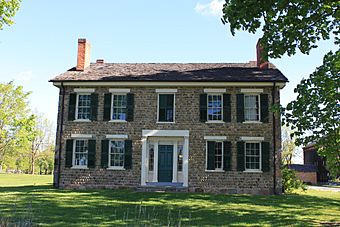Cobblestone Farm and Museum facts for kids
|
Dr. Benajah Ticknor House
|
|

Front view
|
|
| Location | 2781 Packard Rd., Ann Arbor, Michigan |
|---|---|
| Area | 4 acres (1.6 ha) |
| Built | 1835 |
| Built by | Steven Mills |
| Architectural style | Cobblestone construction, Classical Revival |
| NRHP reference No. | 72000662 |
Quick facts for kids Significant dates |
|
| Added to NRHP | November 21, 1972 |
The Cobblestone Farm and Museum is a cool historical place in Ann Arbor, Michigan. It's also known as the Dr. Benajah Ticknor House. The museum gets its name from the special cobblestone rocks used to build the main farmhouse. This important site was added to the National Register of Historic Places in 1972. It also became a Michigan State Historic Site in 1973.
Contents
History of Cobblestone Farm
The land where Cobblestone Farm stands today has been used as a farm since 1824. It continued to be a working farm for a very long time. Ezra Maynard was the first person to clear this land.
Early Owners and the Ticknor Family
In 1835, Ezra Maynard sold the property to Heman Ticknor. Heman bought it for his brother, Dr. Benajah Ticknor. Dr. Ticknor was a surgeon in the Navy.
That same year, Heman Ticknor built a small wooden house on the land. Later, in 1844, Dr. Benajah Ticknor built the famous cobblestone farmhouse. He likely had help from a builder named Steven Mills.
Dr. Benajah Ticknor traveled a lot for his Navy work. But in 1854, he retired and moved to the farm. He lived there with his wife, Getia, and their two adopted daughters. Dr. Ticknor passed away in 1858. After he died, his large collection of medical books was given to the University of Michigan.
Later Families and Becoming a Museum
In 1860, Horace Booth bought the farm from Getia Ticknor. Horace and his son, Nelson, worked hard on the farm. They even added a fountain that you can still see today.
In 1881, William Campbell bought the farm. His family continued to farm the land until 1955. The Campbell family owned the property until 1972. That year, the city of Ann Arbor bought the farm. They wanted to turn it into a museum.
The Farm Today
Today, the farm looks like it did in the mid-1800s. It helps us see what pioneer life was like in the area. The city of Ann Arbor owns the site as a city park. The Cobblestone Farm Association helps manage it.
Besides being an educational museum, the farm is also a place for fun events. People can have picnics, fairs, and even weddings there.
What You Can See at the Farm
The Dr. Benajah Ticknor House is a two-story building. It has a classic style called Classical Revival. The house is built with cobblestones laid in a cool zigzag pattern.
The Main House Details
The front door has special columns called Doric pilasters on each side. The corners of the house have stone blocks called quoins. The back part of the house is a smaller, older section. This was the original wooden house built in 1835.
Inside the kitchen, there is a big fireplace. It has a special oven for baking and a water heater. These were made from bricks shaped by hand. The house has not changed much over the years. Both the outside and inside look mostly original.
Other Buildings on the Property
Besides the main cobblestone farmhouse, the museum has other buildings. There is a large barn, a tool shed, a corn crib, and a smokehouse. You can also see a log cabin from around 1835. This cabin was moved to the farm from another part of Washtenaw County.
Images for kids






